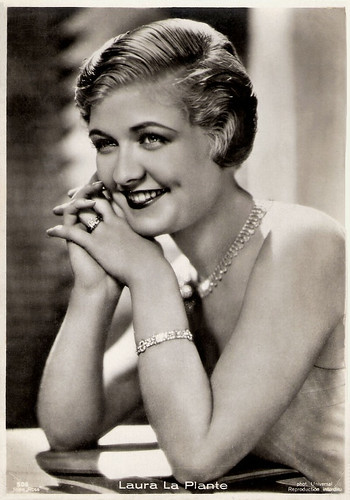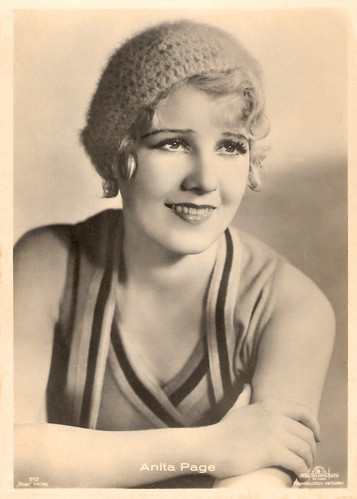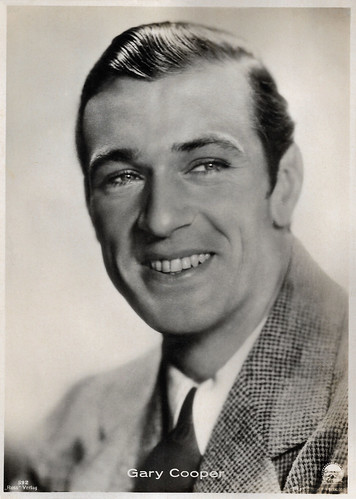
French postcard by Edition Ross in the Luxus series, no. 500. Photo: Clarence Sinclair Bull. Greta Garbo in the German version of Anna Christie (Jacques Feyder, 1930). Mark how Garbo is often portrayed with her hands around her head.
Swedish Greta Garbo (1905-1990) is often regarded as one of the greatest and most glamorous movie stars ever produced by the Hollywood studio system. She was part of the Golden Age of the silent film of the 1920s and was one of the few actors who made a glorious transition to the talkies. She started her career in European cinema and would always stay more popular in Europe than in the USA.

German postcard by Ross Verlag in the Luxus series, no. 501. Photo: Paramount. Marlene Dietrich in Morocco (Josef von Sternberg, 1930).
Marlene Dietrich (1901-1992) is regarded as the first German actress to become successful in Hollywood. Throughout her long career, she constantly re-invented herself, starting as a cabaret singer, chorus girl, and film actress in 1920s Berlin, she became a Hollywood movie star in the 1930s, a World War II frontline entertainer, and finally an international stage show performer from the 1950s to the 1970s, eventually becoming one of the entertainment icons of the 20th century.

German postcard by Ross Verlag in the Luxus series, no. 502. Photo: Ufa.
Willy Fritsch (1901-1973) was the immensely popular ‘Sunny Boy’ of the Ufa operettas of the 1930s and 1940s.

French postcard by Ross in the Luxus series, no. 506. Photo: Universal.
Laura La Plante (1904–1996) was an American actress, best known for her work in the silent film era, such as Smouldering Fires (Clarence Brown, 1925) with Pauline Frederick, Skinner's Dress Suit (William Seiter, 1926) with Reginald Denny, and The Cat and the Canary (Paul Leni, 1927) with Creighton Hale. In the 1920s she acted in over 60 films, mostly for Universal, including the two-part-talkies The Love Trap (William Wyler, 1929) and Showboat (Harry A. Pollard, 1929).

German postcard by Ross Verlag in the Luxus series, no. 510. Photo: Paramount.
Red-haired, cupid-bow-mouthed Nancy Carroll (1903-1965) became a very popular Hollywood star upon the advent of sound film because of her singing and dancing abilities. She was reported to have received more fan mail than any of her Hollywood peers of the same era. As she expanded her acting range from flaming flapper to ditzy comedienne to sensitive heroine, she was nominated for an Oscar for The Devil's Holiday (1930).

German postcard by Ross Verlag in the Luxus series, no. 512. Photo: Metro-Goldwyn-Mayer.
Hollywood star Anita Page (1910-2008) starred in the silent era opposite Ramon Novarro in The Flying Fleet (1928) and William Haines in Telling the World (1927). Her success in Our Dancing Daughters (1928) opposite Joan Crawford and Broadway Melody (1929) opposite Bessie Love paved the way for a smooth career in sound cinema. In the early 1930s, Anita Page had a busy career in American movies opposite actors like Buster Keaton, John Gilbert, Walter Huston, Robert Montgomery, and Clark Gable (with whom she was romantically involved). After Garbo, she was the actress who got the most fan mail and Mussolini supposedly kept proposing to her.

Postcard by Ross Verlag in the Luxus series, no. 519. Photo: Atelier Balázs, Berlin.
The Austrian actor Willi Forst (1903-1980) was a darling of the German-speaking public. He was also one of the most significant directors, producers, writers, and stars of the Wiener Filme, the light Viennese musical comedy of the 1930s. On stage, he played in operettas and revues but also worked with Erwin Piscator and Max Reinhardt.

German postcard by Ross Verlag in the Luxus series, no. 526. Photo: Ufa. Willy Fritsch.

German postcard by Ross Verlag in the Luxus series, no. 531. Photo: Paramount.
Maurice Chevalier's (1888-1972) trademark was a casual straw hat, which he always wore on stage with a cane and a tuxedo.

German postcard by Ross Verlag in the Luxus series, no. 533. Photo: Paramount.
American actress Clara Bow (1905-1965) rose to stardom as an uninhibited flapper in silent films during the 1920s. Her appearance as a plucky shopgirl in the film It (1927) brought her global fame and the nickname 'The It Girl'. Bow came to personify the Roaring Twenties and is described as its leading sex symbol.

German postcard by Ross Verlag in the Luxus series, no. 540. Photo: Paramount. Charles Rogers in Heads Up (Victor Schertzinger, 1930).
Charles 'Buddy' Rogers (1904-1999) was an American film actor and musician. During the peak of his popularity in the late 1920s and early 1930s, he was publicised as "America's Boy Friend". Rogers starred in such films as Wings (1927) and My Best Girl (1927), opposite his later wife Mary Pickford. He also found success as a bandleader and a musician.

German postcard by Ross Verlag in the Luxus series, no. 576. Photo: Ufa. Collection: Marlene Pilaete.
German actress Brigitte Helm (1908-1996) is still famous for her dual role as Maria and her double the evil Maria, the Maschinenmensch, in the silent SF classic Metropolis (Fritz Lang, 1927). After Metropolis she made a string of over 30 films in which she almost always had the starring role. She easily made the transition to sound films, before she abruptly retired in 1935.

German postcard by Ross Verlag in the Luxus series, no. 580. Photo: Metro-Goldwyn-Mayer. Greta Garbo in Romance (Clarence Brown, 1930).

German postcard by Ross Verlag in the Luxus series, no. 592. Photo: Paramount.
American screen legend Gary Cooper (1901-1961) is well remembered for his stoic, understated acting style in more than one hundred Westerns, comedies and dramas. He received five Oscar nominations and won twice for his roles as Alvin York in Sergeant York (1941) and as Will Kane in High Noon (1952).

German postcard by Ross Verlag in the Luxus series, no. 608. Photo: Atelier Binder. Collection: Geoffrey Donaldson Instituut.
Dutch actress Lien Deyers (1910-1965) - also known as Lien Deijers and Lien Dyers - was discovered by famous director Fritz Lang who gave her a part in Spione (1928). She acted in a stream of late silent and early sound films. After 1935 her star faded rapidly and her life ended in tragedy.

German postcard by Ross Verlag in the Luxus series, no. 609. Photo: Atelier Binder, Berlin.
Austrian-born stage actress Mady Christians (1892-1951) was a star of the German silent cinema and appeared in Austrian, French, British and Hollywood films too.

German postcard by Ross Verlag in the Luxus series, no. 614. Photo: Paramount. Jenny Jugo in Die nackte Wahrheit/The Naked Truth (Karl Anton, 1932). It was shot at the Joinville Studios in Paris, where many of Paramount Pictures' multiple-language versions were made. It is the German version of Nothing but the Truth (Victor Schertzinger, 1929) and was also known by the alternative title of Heut' küsst Paris.
Pretty Austrian actress Jenny Jugo (1904-2001) had a prolific career in German cinema, from the late silent era well into the war years. She did particularly well as a comedienne and starred between 1931 and 1942 in eleven smart and charming comedies directed by Erich Engel.

German postcard by Ross Verlag in the Luxus series, no. 618. Photo: Paramount. Marlene Dietrich.

German postcard by Ross Verlag in the Luxus series, no. 627. Photo: Atelier Binder, Berlin / Ufa.
British-born, German actress and singer Lilian Harvey (1906-1968) was Ufa's biggest star of the 1930s. With Willy Fritsch, she formed the 'Dream Team of the European Cinema'. Their best film was the immensely popular film Operetta Der Kongress tanzt/The Congress Dances (Erik Charell, 1931).

German postcard by Ross Verlag in the Luxus series, no. 657 (Schwarz Chamois version). Photo: Clarence Sinclair Bull / Metro-Goldwyn-Mayer. Greta Garbo in Mata Hari (George Fitzmaurice, 1931).

German postcard by Ross Verlag in the Luxus series, no. 657 (Schwarz Hochglanz version). Photo: Clarence Sinclair Bull / Metro-Goldwyn-Mayer. Greta Garbo in Mata Hari (George Fitzmaurice, 1931).

German postcard by Ross Verlag in the Luxus series, no. 669. Photo: Walter Lichtenstein.
German stage and screen actor Felix Bressart (1892-1949) had to flee Germany after the Nazis seized power. He continued his film career in Austria and later in the US, where he became a popular character actor for MGM.

German postcard by Ross Verlag in the Luxusklasse series, no. 673. Photo: Ufa.
Ethereally blonde Camilla Horn (1903-1996) was a German dancer and film star. Her breakthrough role was Gretchen in the silent film classic Faust (Friedrich Wilhelm Murnau, 1926). She also starred in some Hollywood films of the late 1920s and in a few British and Italian productions.

German postcard by Ross Verlag in the Luxus series, no. 700. Photo: Atelier Binder. Collection: Geoffrey Donaldson Instituut. Lien Deyers.

German postcard by Ross Verlag in the Luxus series, no. 701. Photo: Metro Goldwyn Mayer. Greta Garbo and Ramon Novarro in Mata Hari (George Fitzmaurice, 1931).
Mexican-American actor Ramon Novarro (1899-1968) was a popular Latin Lover of the 1920s and early 1930s.

German postcard by Ross Verlag in the Luxus series, no. 745. Photo: Godfried de Groot, Amsterdam.
Popular actress Renate Müller (1906-1937) was the toast of late 1920s Berlin. She had a comet-like career in the early German sound cinema, that was abruptly ended by her mysterious early death.

German postcard by Ross Verlag in the Luxus series, no. 762. Photo: Ufa. Hans Albers in F.P.1 antwortet nicht/F.P.1 Doesn't Answer (Karl Hartl, 1932).
Jovial, pleasantly plump Hans Albers (1891-1960) was a superstar of German cinema between 1930 and 1945. He was also one of the most popular German singers of the twentieth century. His song 'Auf der Reeperbahn nachts um halb eins' (On the Reeperbahn at half past midnight) is the unofficial anthem of Hamburg’s neighbourhood of St. Pauli, famous for its brothels, music, and nightclubs.

German postcard by Ross Verlag in the Luxus series, no. 766. Photo: Atelier Yva, Berlin.
German-born, British stage and screen actress Dolly Haas (1910-1994) was popular in the 1930s as a vivacious, red-haired 'gamine' often wearing trousers in German and British films. Although she got a 3-year contract with Columbia and worked with Alfred Hitchcock in Hollywood, Dolly's American career mainly took place on and Off-Broadway.
Source: Hans Schnepper (Ross Postcards). Thanks to Marlene Pilaete! Our Ross Verlag tribute will be continued next week!
2 comments:
I appreciate your work. Next post and next amazing cards :)
Thank you very much. Greetings from Amsterdam!
Post a Comment